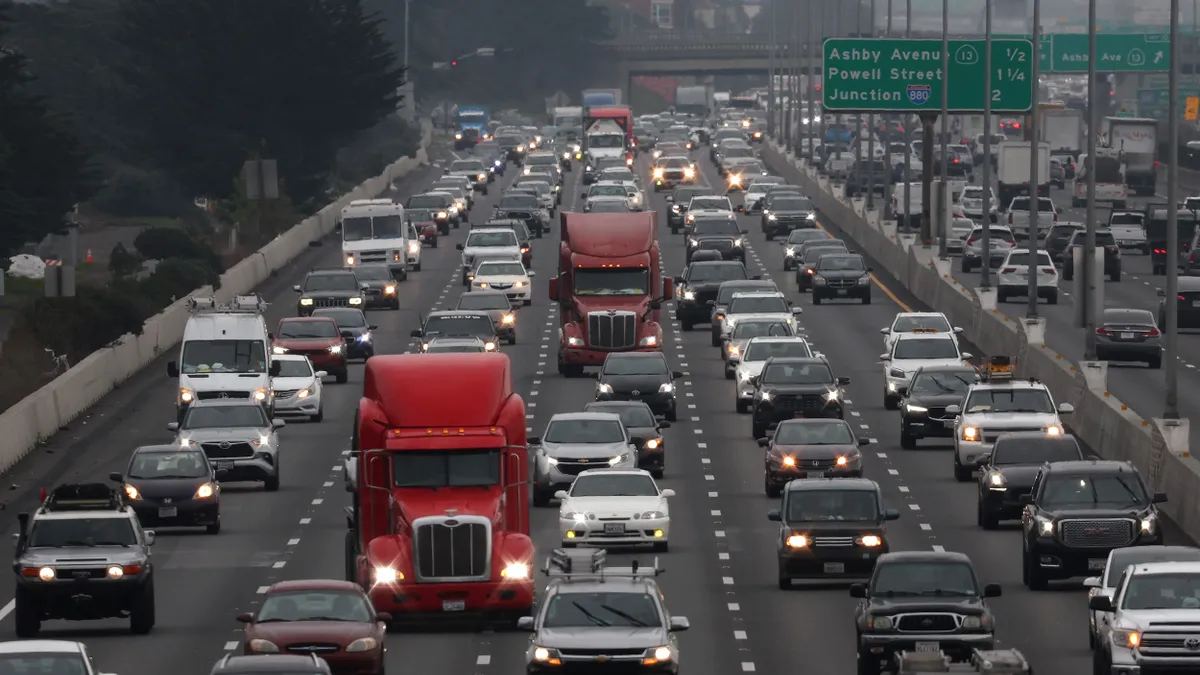When Nadine Lee took over as president and CEO of Dallas Area Rapid Transit on July 12, 2021, she walked into an empty office suite at a pandemic-stricken agency with ridership that had fallen by half from 2019 to 2021.
Although her office was quiet, the workload was daunting. DART was busy constructing a new 26-mile rail line and redesigning the system’s bus network. The agency needed to hire more bus operators, and the city of Anna, Texas, a northern suburb, wanted DART to clean up its trash-strewn right-of-way through the city.

“Everything was my first priority,” Lee said. She had just come from a six-year stint at the Los Angeles County Metropolitan Transportation Authority, where she most recently served as chief of staff. Lee described her first few months at DART as just “trying to understand the landscape here” but said she found a “sense of optimism in this whole region which, to me, [was] very heartening.”
Security, cleanliness are top rider concerns
DART is a regional transit agency that serves 13 cities, including Carrollton, Dallas, Highland Park, Irving and Plano in North Texas. It operates a 93-mile light rail system, nearly 700 buses, the 34-mile Trinity Railway Express commuter line and the Dallas streetcar. Other services include a van pool and paratransit service. Total ridership in 2021 was just over 35.3 million.
Lee found DART in sound financial shape when she arrived. Much like LA Metro, DART relies mainly on a dedicated sales tax, which provided 64% of all revenue in 2021, with only 3% coming from passenger fares.
Despite that good news, riders have complained about rising crime, harassment and substance abuse on the trains and buses, according to the Dallas Morning News. According to DART data, 1,334 incidents were reported from January to October 2022, including assaults, drug offenses, robberies, thefts, vandalism and weapon violations. During that period, 981 arrests were made on the system.
DART increased police patrols in key locations and conducted a pilot program to address concerns about incidents involving people experiencing homelessness or facing mental health issues. In August, DART hired a new chief of police. “We're going to look at security very comprehensively,” Lee said.
Lee sees security, cleanliness and reliability as key to improving the rider experience. In November, the agency launched a pilot program to remove trash and debris on light rail trains on weekdays from 6:00 a.m. to 10:00 p.m. in addition to the nightly cleaning. Lee said she wants riders “to understand that it matters to us that it's clean for them.”
Like many other transit agencies, DART struggles with an industrywide labor shortage. Salaries for the agency’s police officers were “woefully behind” prevailing wages, Lee said, and lacking enough bus drivers, DART had to cut service in June. “We were missing about 15% of our trips and, in some cases, were missing an entire afternoon of runs,” she said.
In response, DART raised wages, offered hiring bonuses and held hiring events for both police officers and bus operators, Lee said. That allowed the agency to restore many of the bus routes to full service and to get more applicants for its police department, she added.
Low ridership, low transit use remain concerns
Ridership remains about 60% below pre-pandemic levels. Through September of this year, 43.1 million riders have used DART across all modes, compared to 70.8 million for the same period in 2019.
The Dallas-Fort Worth-Arlington area has one of the lowest rates of public transportation use of all major U.S. cities. In 2019, just 1.3% of all workers in the region used transit for their commute, according to a U.S. Census Bureau American Community Service report.
“We’ve got to think about who's riding today and how much they need us,” said Lee. In the past, DART favored rail over bus transit, she said. “An agency like ours running only 700 buses doesn't make a whole lot of sense because we've got two and a half million people in our service area. It seems like we should be running at least 1,200 buses, but that's not the case.”
“I really needed to work in public service.”
A professional engineer by trade, Lee grew up in Columbia, Missouri. She spent her early career with engineering and design firms but found an opportunity to work with the Denver-area Regional Transportation District. “I just felt like I really needed to work in public service,” she said. At RTD, she worked on rail projects and oversaw the development of the agency’s Flatiron Flyer bus rapid transit project.
Lee joined LA Metro in 2015 as deputy chief innovation officer in the Office of Extraordinary Innovation, where she worked on the agency’s 10-year strategic plan. Later, as chief of staff, she focused on equity issues and the importance of the customer’s experience with the agency’s buses and trains. All of that background “culminates in some really fun perspectives about what we can do here at DART,” she said.
“I feel like my career was like a ‘Slumdog Millionaire’ kind of experience, in that I dabbled in so many different things that it all added up to preparing me for this role,” Lee said in a lengthy interview.
Lee traveled abroad to learn about transit systems in other countries and served on the leadership committee of the American Public Transportation Association. In 2019, WTS International, an organization dedicated to the advancement of women in transportation, named Lee International Woman of the Year.
“I'm very much an advocate for women advancing in their careers, specifically in transportation,” said Lee. DART’s staff responded positively to her appointment as CEO, she noted. “I didn't realize how much of an impact it was for people here to have a female CEO. When they see somebody like them at the top, it gives them a different perspective on the future of the organization.”
Strong growth marks the Dallas region
The Dallas-Fort Worth metro area now ranks as the fifth-fastest growing economy in the U.S., according to an October report from the Kenan Institute of Private Enterprise. Along with well-established corporate headquarters in the region such as American Airlines, Southwest Airlines, Texas Instruments and Verizon Communications, companies including Charles Schwab and Toyota have relocated there in recent years. The area’s population is increasingly younger and more diverse. According to DART, the region is expected to add almost 4 million new residents and about 2.2 million more jobs by 2045.
That’s both an opportunity and a challenge, said Lee. “The demand for transportation and mobility continues to grow,” she said. “We’ve got to leverage the transit system as much as possible because the transit system has excess capacity.”
Two major rail projects are in the works. The 26-mile Silver Line light rail project, now under construction, will connect Dallas/Fort Worth International Airport and Plano, running through Addison, Carrollton and Dallas. It’s expected to go into service in 2024. The D2 subway is a proposed second light rail line through downtown Dallas, currently in the design phase. But DART says it “plans to conduct due diligence studies on the project timing” due to changed travel behaviors.
Lee doesn’t see a need for further costly expansion. “We think we have the right network now,” she said. “We just have to add frequency to that network and maybe some of the areas where we see more growth.”
Instead, Lee points to the strategic plan the agency is currently developing, which she expects will be completed in about a year. Her philosophy on this is straightforward: “It's making sure that we understand the customer needs and customer satisfaction, and prioritizing our investments based off of what the customers tell us are most important.”




















